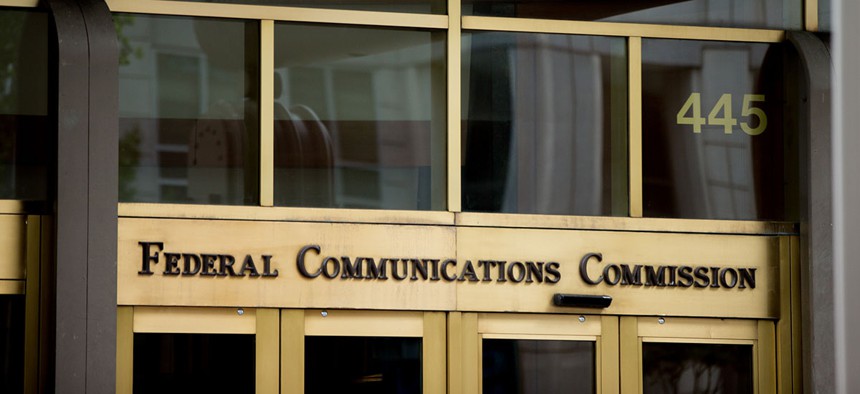It’s Possible to Cut Legacy Spending. Here’s How FCC Did It.

The Federal Communications Commission building in Washington. Andrew Harnik/AP File Photo
The agency took small steps first.
In recent years, legacy IT has shaped up to be one of the government’s biggest tech challenges.
In 2016, then-U.S. Chief Information Officer Tony Scott championed a $3.1 billion IT modernization fund that—while it failed to pass through Congress—ultimately drew significant awareness to how much the government spends and relies on hopelessly outdated systems.
Scott, along with officials from the Government Accountability Office and others, frequently cited that agencies spent on average 80 percent of the government’s $80 billion IT budget on operation and maintenance, leaving 20 percent for modernization and developing new technologies.
» Get the best federal technology news and ideas delivered right to your inbox. Sign up here.
Many agencies fare worse: The Army Corps of Engineers spends 96 percent of its IT budget on O&M and the Housing and Urban Development Department recently came under fire from GAO for spending 95 percent of its IT budget on legacy systems.
There’s a reason the legacy tech challenge is so widespread across government: Modernizing is hard and can be expensive. Yet, some agencies, including the Federal Communications Commission, have done just that.
In 2013, the year CIO David Bray took over as the agency’s top tech official, FCC was spending 85 percent of its $64 million IT budget on legacy systems. Less than four years later, FCC has reduced its legacy spend by 35 percent on the back of an ambitious modernization plan heavy on achieving small wins, moving to cloud computing and ultimately reducing contracted personnel.
“One of the first things I did when I arrived was survey the land and see what we had and how much we were spending,” Bray told Nextgov.
He found 207 various systems, some more than two decades old. Maintaining those systems was an entrenched group of nearly 400 contractors with an average tenure of 15 years. Eighty-five percent of FCC’s IT resources went to keeping the lights on.
“I made the case to leadership that either we do an intervention and get off these systems or that 85 percent would continue to grow,” Bray said. “Plus, legacy software is brittle and things will break and could be compromised. It’s hard to defend old code.”
Bray wasn’t showered with money to make it happen, but he did get the go-ahead to try. He brought in his own small team of innovators from outside government to his ranks, offsetting some federal employees who left, in an effort to infuse innovation. Right off the bat, FCC saved money by replacing its aging Consumer Complaint Center with a software-as-a-solution in around six months—an effort led by Dustin Laun, a Silicon Valley innovator Bray snagged. Instead of the $3.2 million quote to internally build a new system over two years, FCC spent $450,000 for a system that was ready to go in six months.
In another example, FCC also stood up a cloud-based Electronic Comment Filing System without requiring new money from Congress.
These small wins, Bray said, are crucial to larger-scale modernization efforts. They solidify buy-in from higher-ups, and they offer inklings of what might be possible down the line.
“Do it small first,” Bray said. “Find a project or something you’ve written from scratch and a find a commercial solution where you can show a win where it’s cheaper to do SaaS than it is to do on premise.”
In FCC’s case, the small wins led to the agency going all-in on cloud computing, with plans to be nearly 100 percent in the cloud by the conclusion of 2017. That effort is the biggest driver behind FCC’s modernization successes. FCC’s initial inventory found 15 percent of the agency’s internal servers weren’t doing anything aside from adding to its monthly electric bill, so they were promptly pitched.
FCC then orchestrated “Operation Server Lift,” moving its racks of servers to facilities managed and maintained by a commercial cloud provider, leading to an “immediate drop in legacy spend.”
FCC, Bray said, had cleaned house, inventorying all it had and essentially moving the vast majority of what was left to a commercial environment. SaaS is FCC’s new modus operandi, not hogging servers and developing millions of lines of code.
The net effect has significantly reduced FCC’s contracting workforce, from 380 pre-lift to around 180 today, while the government workforce has stayed roughly the same size. The contractor issue is important in any modernization effort, Bray said, because incumbent contractors in any agency profit off legacy systems.
"You have to tackle that head on by engaging contractors and the government workforce and telling them there will be great opportunities for anyone who embraces the new model of delivering results, and that the current model is not serving taxpayers,” Bray said.
The modernization effort has also freed up significant cash, which Bray said the agency can turn around to focus employees “on more mission-specific things we need to do at the FCC,” like the new FCC website. It was funded by using money available because FCC wasn’t spending all its money on old stuff.
NEXT STORY: Alexa Is Coming to the iPhone



